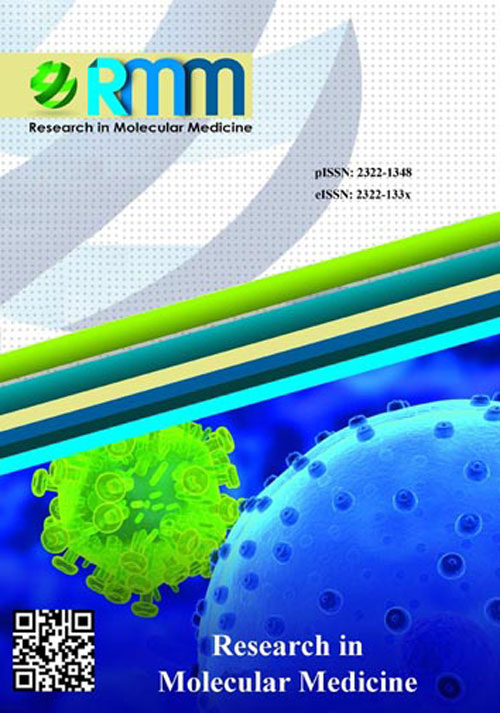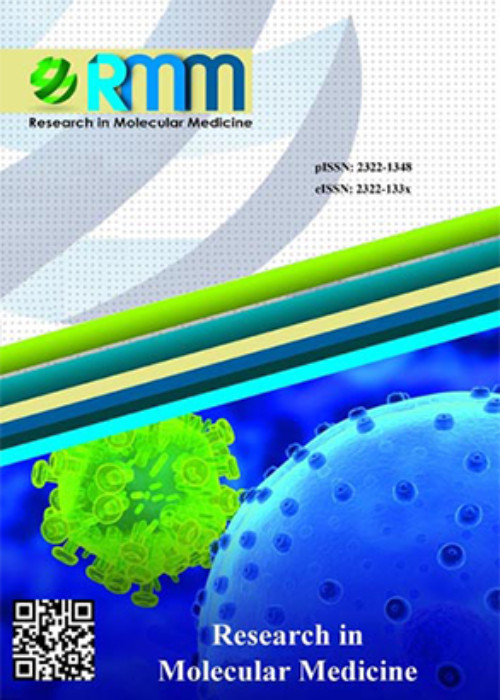فهرست مطالب

Research in Molecular Medicine
Volume:4 Issue: 2, Jun 2016
- تاریخ انتشار: 1395/02/15
- تعداد عناوین: 7
-
-
Pages 9-14BackgroundUrinary tract infections are one of the most frequent health problems and Uropathogenic Escherichia coli is the major pathogen resulting UTIs. The severity of UTIs is caused by the expression of a large range of virulence factors.In this study, we evaluated the allelic frequency fimH gene, in UPECs isolated from patients with UTIs. This study also aimed to determine the roles of C640T and T591A SNPs of the fimH gene in the ability of UPEC to cause UTIs.
Material andMethodsA total of 140 UPEC strains isolated from patients with UTIs were screened by PCR-RFLP for determining the prevalence of the C640T and T591A SNPs of fimH gene in UPEC strains isolated from patients referred to educational hospitals of Shahrekord. The genotyping of C640T and T591A SNPs was performed using Bme1390I and BseNI restriction enzymes, respectively through PCR-RFLP method.ResultsThere were no meaningful association between C640T and T591A SNPs of fimH gene and the ability of UPEC fimH variants to cause UTIs in the studied E. coli isolates.ConclusionFimH is one of the most major virulence factors among UPECs which is confirmed in most E. coli isolates. Further studies are required to determine the association between different fimH gene SNPs of isolated UPECs from UTIs patients and the ability of UPEC fimH variants to cause UTIs.Keywords: UTIs, fimH, C640T, T591A SNPs, PCR, RFLP -
Pages 15-23BackgroundLimited yield and poor specificity are resulted in improving the PCR amplification of GC-rich DNA sequences. In this study, the Lipophosphoglycan 3 (LPG3) gene of the lizard- and mammalian Leishmania species was amplified under optimized PCR conditions, as well as the molecular characteristics of the predicted LPG3 amino acid sequence was described.Materials And MethodsGenomic DNA extracted from Leishmania species was amplified by adding various additives in the reaction mixture to increase the PCR efficiency of GC-rich target sequence. The desired PCR products were then cloned and sequenced. Next, the Lipophosphoglycan 3 (LPG3) of the L. infantum was compared to the Lipophosphoglycan 3 (LPG3) of the lizard Leishmania at the amino acid sequence level by pairwise alignment and phylogenetic analysis.ResultsThe combination of betaine and 2-mercaptoethanol with bovine serum albumin as well as betaine in combination with bovine serum albumin could further promote PCR amplification yield and specificity relative to conditions using either one of the additives. The results may provide a simple modified PCR protocol which is capable of improving the efficiency of PCR amplification of DNA templates with high GC-content. Deduced amino acid alignment showed 95% identity between Leishmania infantum and lizard Leishmania. Leishmania infantum was also clustered with lizard Leishmania in the phylogenic tree. A significant spatial arrangement of secondary structure was observed in the LPG3 of both Leishmania species. Moreover, the prediction of tertiary structure indicated molecular homology.ConclusionAlignment and phylogenetic analysis suggest that the lizard Leishmania may be evolutionarily more close to Leishmania infantum.Keywords: LPG3, Leishmania infantum, PCR additives, GC, rich DNA
-
Pages 24-29BackgroundThe zinc-finger X linked (ZFX) gene encodes a transcription factor that acts as a regulator of self-renewal of stem cells. Due to the role of ZFX in cell growth, understanding ZFX protein-protein interactions helps to clarify its proper biological functions in signaling pathways. The aim of this study is to define ZFX protein-protein interactions and the role of ZFX in cell growth.Materials And MethodsThe PIPs output includes three interacting proteins with ZFX: eukaryotic translation initiation factor 3 subunit I(EIF3I), eukaryotic translation initiation factor 3 subunit G(EIF3G) and protein nuclear pore and COPII coat complex component homolog isoform 3 (SEC13L1).ResultsAs a cargo and transmembrane protein interacting with Sec13,eIF3I and eIF3G, ZFX mediates cargo sorting in COPII vesicles at ER exit sites. While traveling to cis-Golgi, eIF3I is phosphorylated by the mechanistic target of rapamycin (mTOR). Proteins transport by COPI vesicles to the nucleusouter site layer containing SEC13 via the contribution of microtubules. EIF3G and eIF3I interact with coatomer protein complex subunit beta 2 (COPB2) that helps to enclose ZFX in COPI vesicle. ZFX and eIF3G enter nucleolus where activation of transcription from pre rDNA genes occurs.ConclusionWe proposed a model in which ZFX is involved in cell growth by promoting the transcription of rDNA genes.Keywords: ZFX, Cell growth, Cancer stem cells, rDNA genes, Protein, protein interactions
-
Pages 30-35BackgroundThe purpose of present study was to investigate whether Sphingosine 1-phosphate (S1P) levels and its receptors gene expressions are correlated with MyoD and myogenin following resistance training.Materials And Methods24 eight-week-old male Wistar rats (190-250 gr) were assigned randomly to a control (N = 12) or training (N = 12) group. Rats climbed a resistance training ladder with weights attached to their tails. The content of plasma S1P and relative mRNA expression were determined by high performance liquid chromatography (HPLC) and Real-time PCR, respectively.ResultsResistance training increased the content of S1P in plasma (P = 0.001) and changed the gene expression of S1P1, S1P2 and S1P3 receptors. There were significant correlations between plasma S1P and gene expression of S1P2,3 receptors with gene expression of MyoD. There are correlations between satellite cells activation markers (MyoD and myogenin) and plasma S1P content and its receptors before and after resistance training.ConclusionIt might be concluded that S1P as a growth mediator may play an important role in skeletal muscle adaptations.Keywords: MyoD, myogenin, S1P, S1P receptor, skeletal muscle
-
Pages 36-43Lymphomas are solid tumors of immune system and Non-Hodgkin Lymphomas (NHL) is the most prevalent lymphomas; with wide ranges of histological and clinical features, it is so difficult to identify them. Herein, various bioinformatics tools (such as gene differential expressions, epigenetics and protein analysis) employed to find new treatment approach for NHL based on gene expression variation between classic Hodgkin and B NHL.
Microarray libraries GSE20011 downloaded from NCBI database and analyzed with GEO2R software, then differential expression genes analyzed by four databases (DAVID, Wikipathways, BioCarta and KEGG databases). Kinase, transcription factor, microRNA analysis and protein-protein interaction network performed by X2K ,ChEA, microRNA TargetScan and Genes2Networks software respectively. Finally, drug target identified and carried out by Drug Pair Seeker and Connectivity MAP databases.
The results showed GATA2 Transcription Factor (TF) up-regulates genes while Sox2 down-regulates them. Functional analysis of up-regulated genes showed highly activation in B cell receptor signaling pathway while programmed cell death and apoptosis program noted in down-regulated genes. Drug discovery facilities revealed that Verteporfin drug induces down-regulated genes while Prochlorperazine represses up-regulated genes. Three microRNA34a34c and miR-449 repressed up-regulated gene networks. The finding paves the roads toward B-NHL therapy with 34a/b and miR-449 microRNAs and Prochlorperazine / Verteporfin drugs.Keywords: B non, Hodgkin lymphoma, Enrichment analysis, System Biology -
Pages 44-46BackgroundIn this study we aimed at detecting the enterotoxin A and B gene of S. aureus in clinical samples of patients attending health centers in Zahedan using molecular methods.Materials And MethodsA cross-sectional study was carried out in which 40 samples of S. aureus were obtained from patients in a hospital in Zahedan, Iran. Following the biochemical tests, Identifications were confirmed by PCR with specific primers.ResultsAmong 40 clinical isolates of S. aureus the frequency of sea gene was 2% and the frequency of seb gene was 8% while the frequency of both sea뇦 genes was 3%.ConclusionEnterotoxin of S. aureus is one of the main factors in the pathogenesis of various diseases and production of these toxins increase the incidence of diseases, so rapid treatment is needed for enterotoxin gene expression.Keywords: Enterotoxin, Food Poisoning, Staphylococcus aureus, Gene
-
Pages 47-51BackgroundA. bovis and A. phagocytophilium are leukocytotropic agents of bovine anaplasmosis. They are obligate intracellular bacteria that can infect and cause Anaplasmosis in human and animals. Therefore, this study was carried out to detect A. bovis and A. phagocytophilum in naturally infected dairy cattle in Isfahan using molecular techniques.Materials And MethodsIn this study a total of 209 blood samples were collected from cattle in central part of Iran (Isfahan). The presence of A. bovis and A. phagocytophilium were examined by species-specific nested polymerase chain reaction (nPCR) based on 16S rRNA gene.ResultsOut of the 209 cattle examined, 4 (1.99%) and 2 (1%) were found positive for A. bovis and A. phagocytophilium by nPCR, respectively.ConclusionThese data showed a relatively low prevalence of leukocytic Anaplasma infection in cattle in central part of Iran.Keywords: A. bovis, A. phagocytophilium, nested, PCR, 16S rRNA gene, Iran


